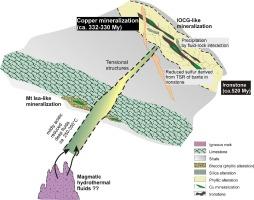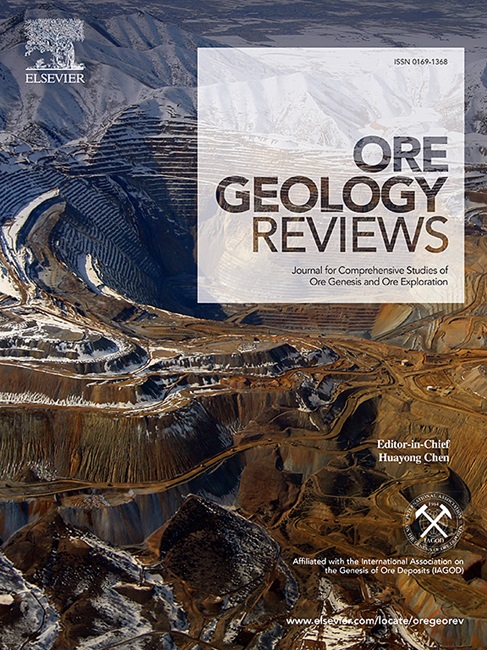Replacive IOCG systems in the Ossa Morena Zone (SW Iberia): The role of pre-existing ironstones as a geochemical trap
IF 3.2
2区 地球科学
Q1 GEOLOGY
引用次数: 0
Abstract
The central Ossa Morena Zone (SW Iberia) hosts a regionally extensive ironstone level interbedded with bimodal volcanic rocks, limestone and shale of Lower-Middle Cambrian age. The stratabound ironstone includes dominant magnetite and hematite with locally abundant chert and barite. It is interpreted as being (sub-)exhalative at or near the seafloor and formed during a rifting event that postdated the Cadomian orogeny. In some places, such as in the Las Herrerías deposit, the ironstone is irregularly replaced by a chalcopyrite-rich ore; the Cu-rich mineralization is accompanied by the pervasive phyllic alteration of the hosting siliciclastic sediments. The highest copper grades are found when the ironstone is crosscut by WNW-ESE-trending late-Variscan extensional brittle-ductile structures that are interpreted as the feeder channels for deep hydrothermal fluids. A similar nearby copper-rich mineralization (Pallares) is likely controlled by the tectonic contact between limestone and pyrite-rich black shale.
Sr-Nd whole-rock isotope geochemistry data suggests that the Sr in the ironstone (87Sr/86Sri ≈ 0.7088) is close to isotopic equilibrium with the local exhalative barite (0.7084–0.7086) and Cambrian seawater. The ironstone has a significantly more crustal εNd initial signature (<-1.8) than the coeval volcanic rocks (+5.2 to + 7.9). The younger sulfide mineralization inherited the Nd isotope composition of the ironstone but shows a significant enrichment in 87Sr (87Sr/86Sr > 0.7091) that is interpreted as related with the input of genetically different and more crustally-derived hydrothermal fluids.
39Ar-40Ar dating of the phyllic alteration suggest that the copper mineralization was formed at ca. 332–330 My. These ages are coeval with those of small peraluminous granite intrusions that host Cu-Au vein-like mineralization and dated at 331.8 ± 1.6 Ma (LA ICPMS U-Pb zircon). Our interpretation is that the copper-rich mineralization at the Las Herrerías area is the distal expression of an intrusion-related hydrothermal system.
Numerical modelling shows that ironstone is an effective trap for copper precipitation due to the large changes in pH and fO2 that take place when copper-bearing acid and reduced fluids react with the brittle ironstone. The precipitation of chalcopyrite, however, is controlled by the amount of available reduced sulfur in the ore trap. The δ34S values of the sulfides (+12.6 to + 21.6 ‰) suggest that the most likely source for the reduced sulfur is the thermogenic reduction of aqueous sulfate equilibrated with the exhalative barite (δ34S, +31.4 to + 35 ‰) with some minor input of reduced sulfur leached from the metasediments.
This system could be considered as a variant of the IOCG clan. The formation of the ironstone and the copper mineralization, however, are separated by more than 200 My. Probably, many IOCG systems have a similar origin as Las Herrerías, with an ironstone being just a passive geochemical trap for the copper–gold mineralization.

奥萨-莫雷纳区(伊比利亚西南部)的替代性 IOCG 系统:原有铁矿石作为地球化学陷阱的作用
奥萨-莫雷纳区中部(伊比利亚西南部)有一个区域性大面积铁岩层,与双峰火山岩、石灰岩和页岩互层,时代为下-中寒武纪。地层中的铁岩主要包括磁铁矿和赤铁矿,局部还有丰富的白垩岩和重晶石。它被解释为海底或海底附近的(次)喷出岩,形成于卡多米亚造山运动之后的断裂事件中。在某些地方,如 Las Herrerías 矿床,铁岩不规则地被富含黄铜矿的矿石所取代;富铜矿化伴随着寄主硅质沉积物的普遍植蚀作用。铜品位最高的地方是铁岩被瓦利斯坎晚期的西北西-东东东走向的伸展脆性-韧性构造横切的地方,这些构造被解释为深层热液的给水通道。Sr-Nd 全岩同位素地球化学数据表明,铁质岩中的 Sr(87Sr/86Sri ≈ 0.7088)与当地的外喷重晶石(0.7084-0.7086)和寒武纪海水接近同位素平衡。铁岩的地壳εNd初始特征(<-1.8)明显高于共生火山岩(+5.2至+7.9)。较年轻的硫化物矿化物继承了铁质岩的钕同位素组成,但显示出 87Sr (87Sr/86Sr > 0.7091)的明显富集,这被解释为与输入的基因不同且来源于地壳的热液有关。39 植物蚀变的 Ar-40Ar 测定表明,铜矿化形成于大约 332-330 My。39Ar-40Ar年代测定结果表明,铜矿化形成于大约 332-330 My。这些年代与小型过铝花岗岩侵入体的年代相同,这些侵入体中含有类似铜-金矿脉的矿化物,其年代为 331.8 ± 1.6 Ma(LA ICPMS U-Pb 锆石)。我们的解释是,Las Herrerías 地区的富铜矿化是与侵入有关的热液系统的远端表现。数值模拟显示,当含铜的酸性和还原性流体与脆性铁岩发生反应时,pH 值和 fO2 会发生巨大变化,因此铁岩是铜沉淀的有效捕集层。不过,黄铜矿的沉淀受矿石捕集层中可用还原硫数量的控制。硫化物的δ34S值(+12.6至+21.6‰)表明,还原硫最可能的来源是与外喷重晶石(δ34S,+31.4至+35‰)平衡的硫酸水溶液的热生还原,以及从基岩中沥滤出的少量还原硫。然而,铁岩的形成与铜矿化相距 200 多英里。也许,许多 IOCG 系统的起源与 Las Herrerías 相似,铁岩只是铜金矿化的被动地球化学陷阱。
本文章由计算机程序翻译,如有差异,请以英文原文为准。
求助全文
约1分钟内获得全文
求助全文
来源期刊

Ore Geology Reviews
地学-地质学
CiteScore
6.50
自引率
27.30%
发文量
546
审稿时长
22.9 weeks
期刊介绍:
Ore Geology Reviews aims to familiarize all earth scientists with recent advances in a number of interconnected disciplines related to the study of, and search for, ore deposits. The reviews range from brief to longer contributions, but the journal preferentially publishes manuscripts that fill the niche between the commonly shorter journal articles and the comprehensive book coverages, and thus has a special appeal to many authors and readers.
 求助内容:
求助内容: 应助结果提醒方式:
应助结果提醒方式:


